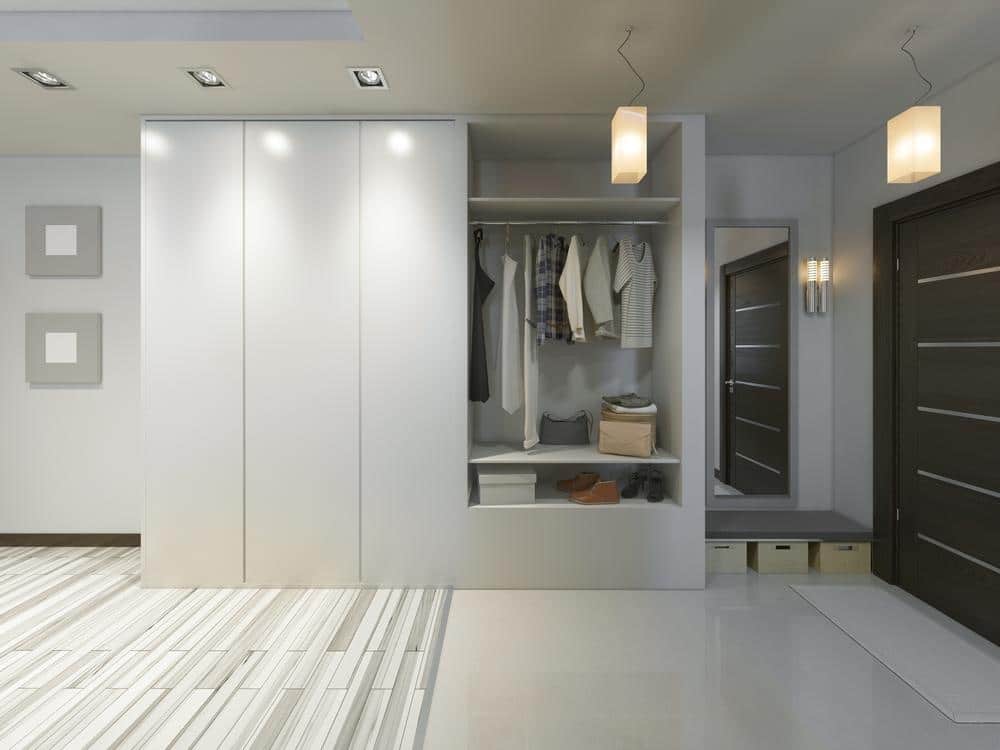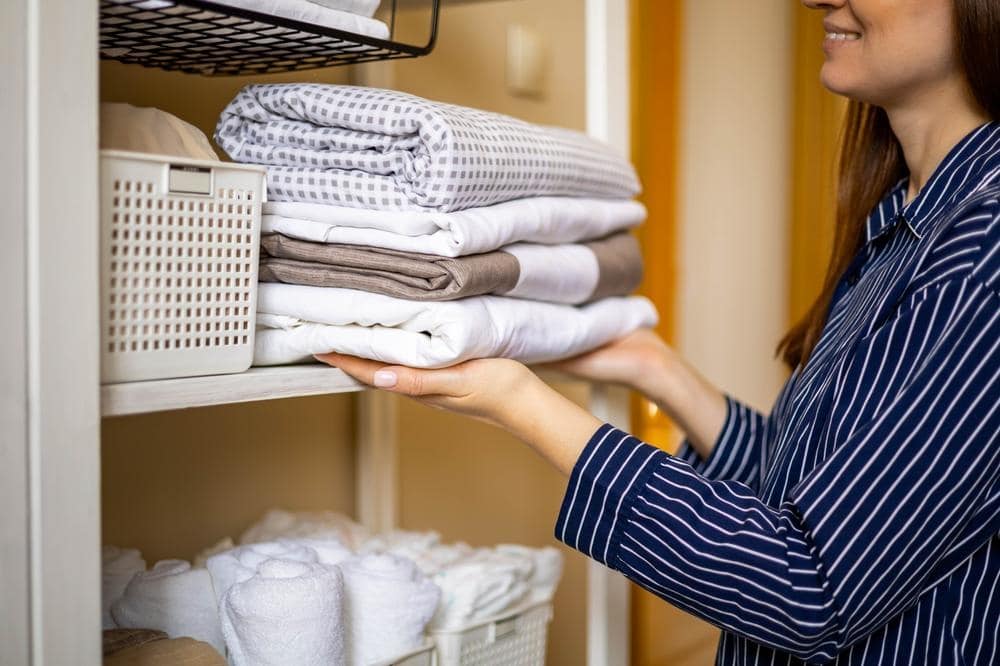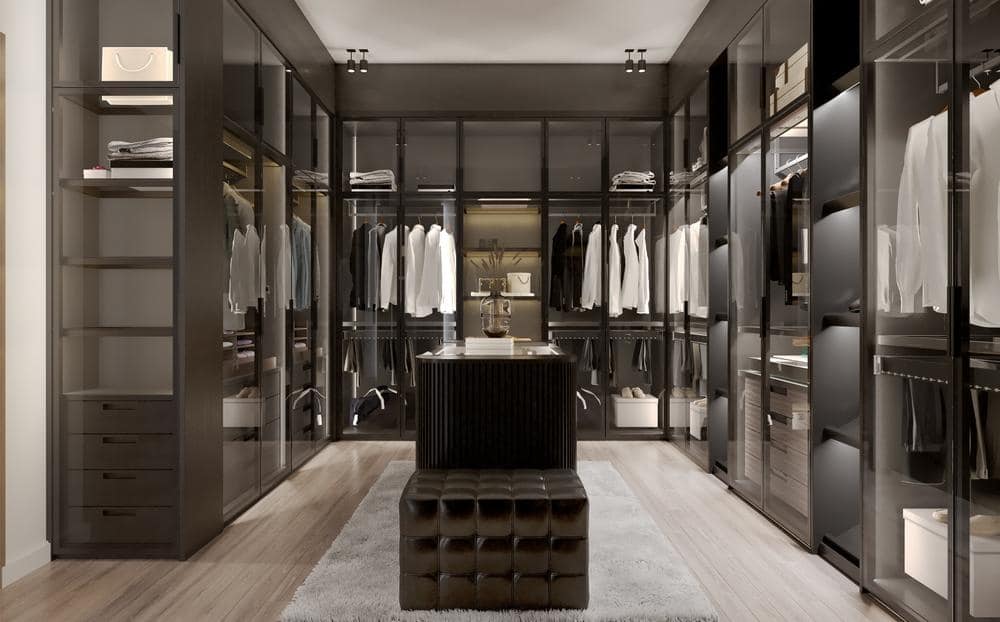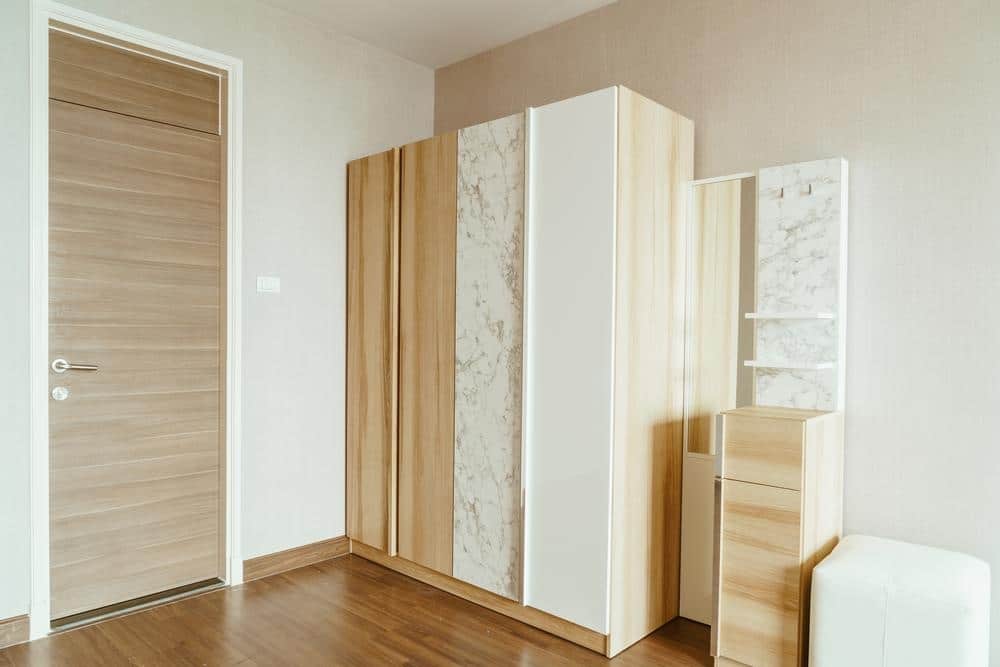If you’re tired of cramming your groceries into a small storage space, it might be time to consider converting a regular closet into a pantry closet. A pantry is a much better option than storing non-perishables in inconvenient places. All you have to do is keep up. From start to finish, we’ve thoroughly researched the best method for converting your closet into a pantry.

Make sure your closet is dark, dry, calm, and empty before converting it into a pantry. Then take the following steps:
- Gather your tools and materials.
- Remove any closet rods or shelving you do not want to be visible in the finished product.
- Fill in any gaps with spackle. Choose a bright color to paint the walls. Removable wallpaper is another excellent option.
- Install an overhead light if your closet lacks one. We recommend battery-powered LED lights that are easy to stick on or screw.
- Plan out where you want your shelves to go by measuring the length and depth of the closet. Your frames will require some support, such as ledges (boards that run along the sides of the cabinet) or brackets.
- Install your shelves to their supports and start organizing your new pantry!
You could hire a professional to do all of this for you, including adding fancy features. Continue reading to learn how to achieve the best results possible.
Qualities Of A Good Pantry
Table of Contents
- Qualities Of A Good Pantry
- 1- What Are the Tools and Materials Required to Build a Closet Pantry?
- 2- How Much Does It Cost to Convert a Closet to a Pantry?
- 3- Preparation and Painting of the Walls
- 4- Lighting for Converting a Closet Into a Pantry
- 5- Determine Your Shelving Needs for Converting a Closet Into a Pantry
- 6-Install Your Shelving to Convert a Closet Into a Pantry
- How Do You Build Closet Pantry Shelves?
- How Should I Arrange My Small Pantry Closet?
- How to Make a Wooden Pantry
- Conclusion
- How much does it cost to turn a closet into a pantry?
- Are walk-in pantries a waste of space?
- How do you make a homemade pantry?
- How do you make a pantry when you don’t have one?
- Are walk-in pantries a waste of space?
- What to do when there’s no pantry in the kitchen?
- How do you organize cabinets if you don’t have a pantry?
- How deep should a pantry closet be?
- Does a pantry need a door?
- Do pantries add value to a home?
- Can you turn a closet into a pantry?
- How much does it cost to convert a closet to a pantry?
- How to build a pantry closet?
- What is a secret pantry?
- Can I Turn a Closet into a Pantry?
- How Much Does It Cost to Convert a Closet to a Pantry?
- How Do I Make My Closet Pantry Functional?
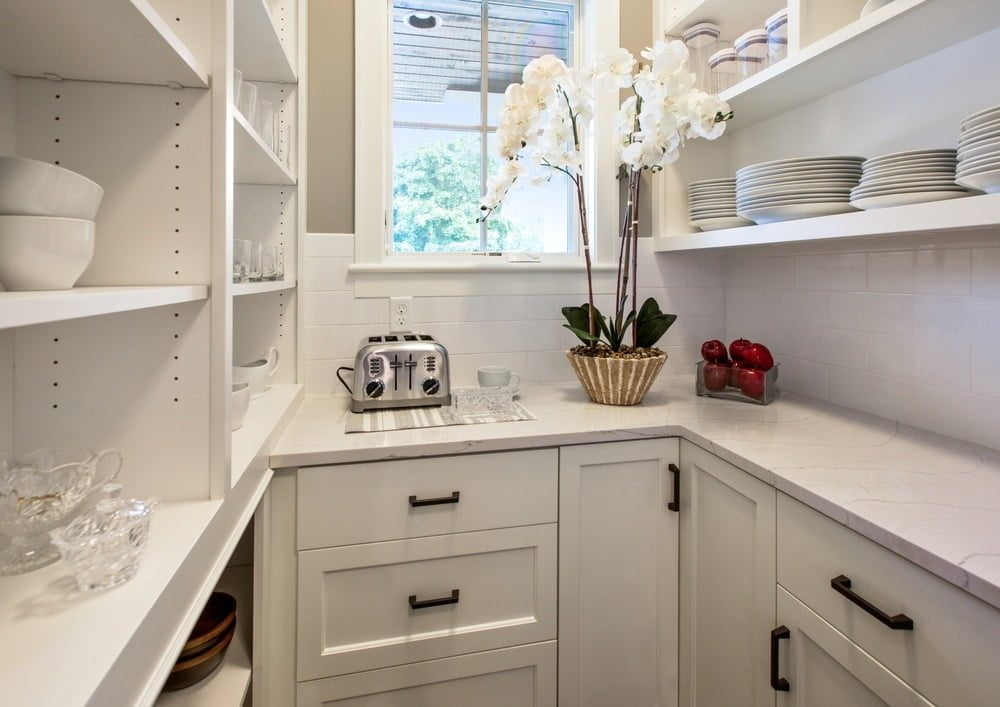
Your pantry should not be located near appliances that emit heat or on the lower levels of your home. Also, avoid areas that receive a lot of sunlight. Light can also hurt the quality of your food. Because most closets are dark, you’re probably in luck. Your pantry should be illuminated only when you’re looking for an ingredient.
Finally, your closet should be dry. Mold growth can be accelerated by high humidity.
Don’t worry if your closet does not meet those specifications. There are still options available to you, such as a freestanding pantry, and we’ll discuss some of them near the end of this post.
1- What Are the Tools and Materials Required to Build a Closet Pantry?
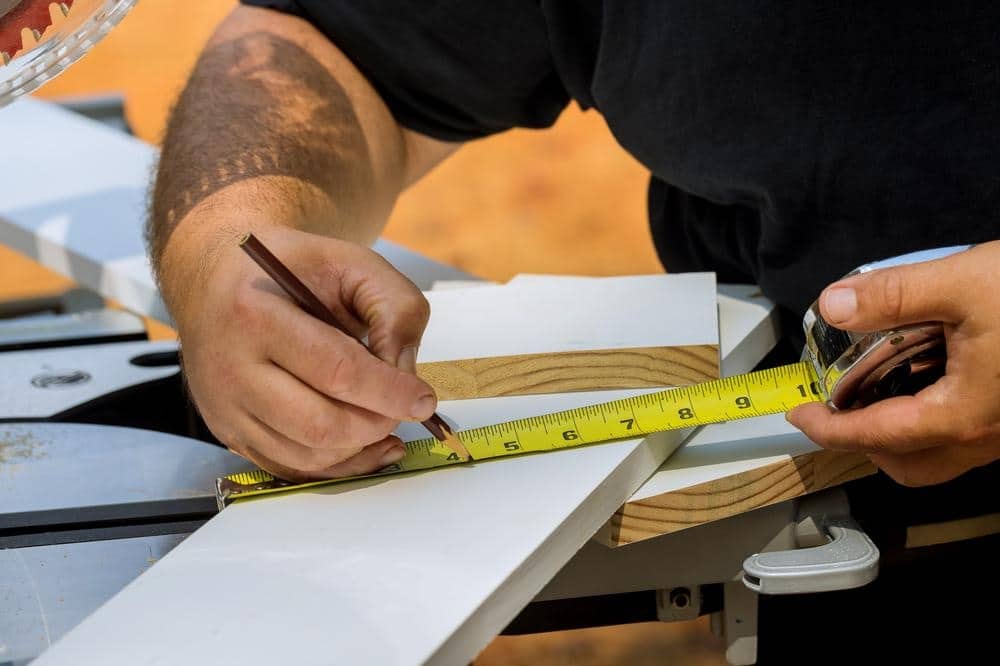
So you’ve decided that your closet would make an excellent pantry. Make sure you have all of the necessary supplies before you begin. Also, make a budget and determine what you want to splurge on and what you want to save on.
The Essentials:
- A practice run
- Screws made of wood (and possibly wall anchors)
- A grade
- A stud hunter
- Tape measure
- Plywood planks for the shelves – Supports brackets, ledges, or both.
Optional Materials:
- Plywood stain and protective finishing
- Fixture for an overhead light
- Spackle and spackling supplies
- Paint, sandpaper, roller, and tray
- Removable wallpaper
- Tape for Painting
- Organizational bins, baskets, and hooks
2- How Much Does It Cost to Convert a Closet to a Pantry?
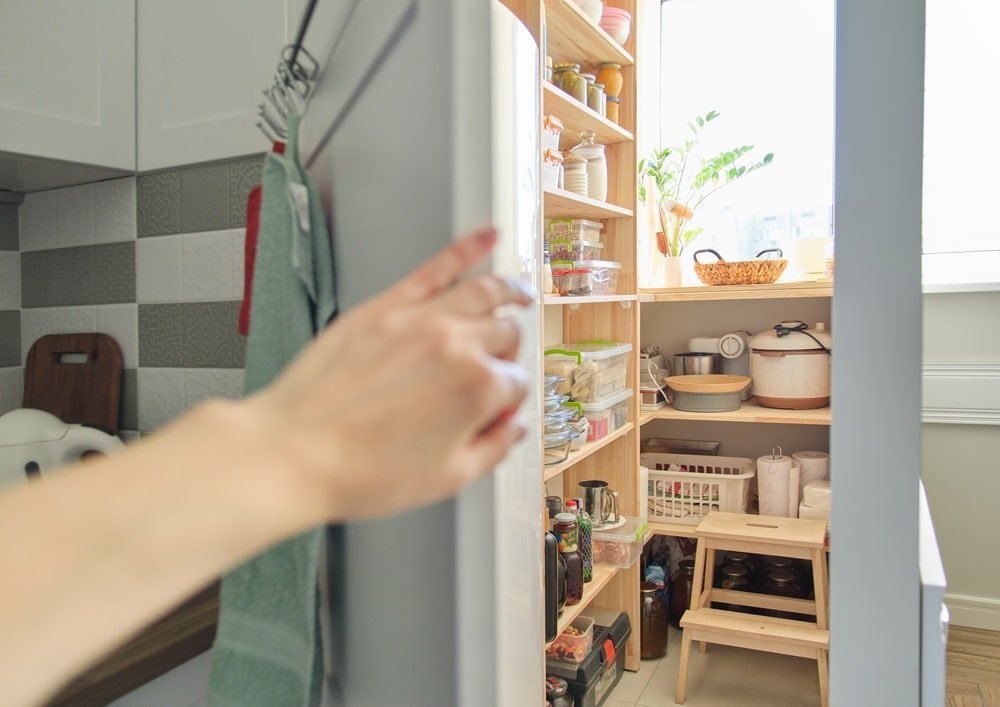
If you bought everything on the list above, you’d spend well over $700. The good news is that most of us don’t require all these things! This project could cost an average of $400.
Your budget will benefit significantly from the tools you already own or can borrow. Many people already have a power drill, a level, a stud finder, and a measuring tape on hand. Consider purchasing these essential tools if you don’t already have them, as they will come in handy far beyond this project.
It is not necessary to purchase or rent a circular saw for this project. Your local hardware store, mainly if it is a large chain, should be able to cut your wood to size for you.
You must determine the appropriate price range for your household. Pricing is also affected by the quality of your materials. You will pay more if choosing higher-quality plywood or upgrading to cherry or oak. Remember that the primary purpose of a pantry is not its appearance, and anything sturdier than plywood is rarely required for holding foodstuffs.
3- Preparation and Painting of the Walls
The polished feel of a pantry is all about crisp and bright walls, so devote some time to them. Spackling should be applied to any screw holes. Here’s a video on YouTube about spackling.
To paint the inside of the pantry, you’ll first need a layer of primer on top of the dried and sanded spackle. When you’re ready to paint, use painter’s tape to avoid accidental splotches on floorboards, light switches, or doorframes.
If you’re nervous about Painting or you’d like an easier option, removable wallpaper is the way to go. It comes in all kinds of striking patterns, and it won’t make a mess.
4- Lighting for Converting a Closet Into a Pantry
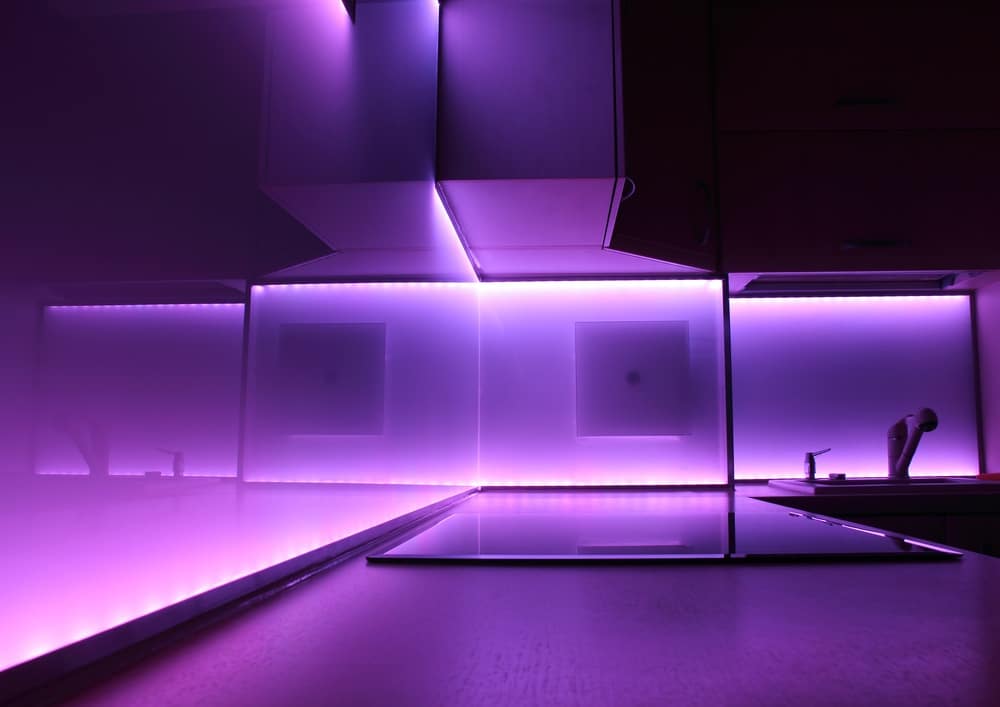
Again, the pantry should be kept dark in general. An overhead light, on the other hand, is ideal for finding that tiny jar of capers or spices that are rarely used. Some of the LED lights are motion-sensor operated, have rechargeable batteries, and stick to the ceiling with strong adhesive. Other options would require an electrician or cords running to the nearest outlet.
5- Determine Your Shelving Needs for Converting a Closet Into a Pantry
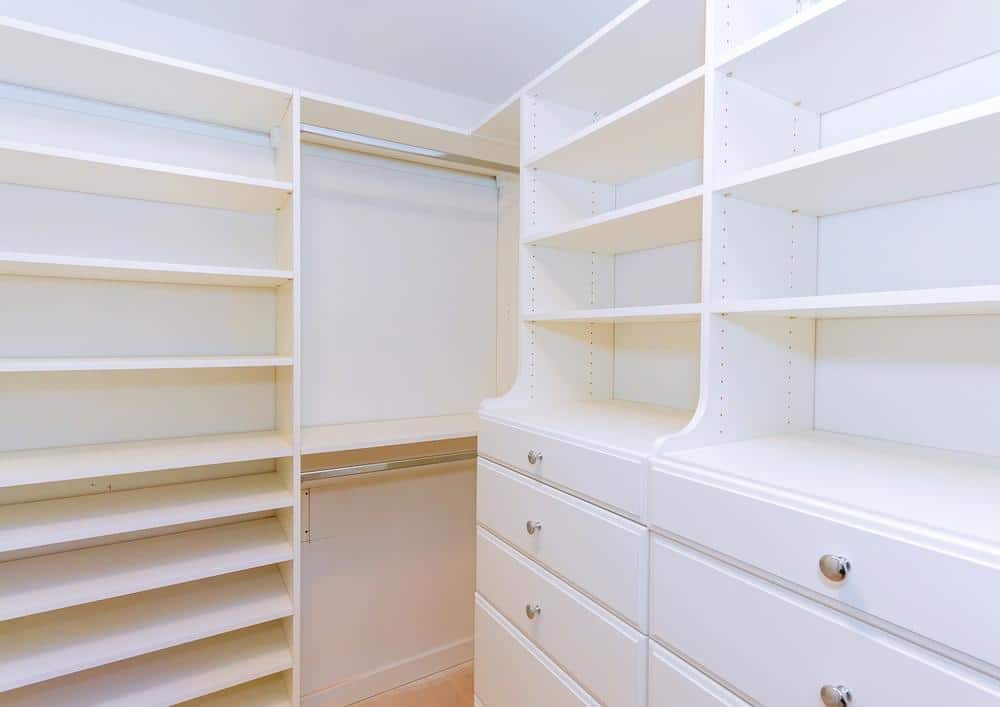
Measure the inside of the closet from left to right and front to back. Make a note of these. Take a few inches off the depth measurement when you go to get the plywood cuts. Shelves that do not extend all the way to the front of the closet make room for wall hooks and make your supplies easier to see and grab.
(If you end up with difficult-to-reach areas, read our best tips for organizing a pantry with deep shelves.)
Painter’s tape comes in handy at this point to help you visualize where you want the shelves to go. The distance between shelves should be determined by your needs.
When you buy the planks, you must also buy wooden ledges or brackets to hold them up. For your ledges, 13-inch blocks of plywood or pine will suffice. They’ll eventually resemble this:
When purchasing brackets, check the packaging to see how much weight they can support. Brackets can also be purely decorative, acting as additional support for the ledges.
Depending on the planks you purchased for your shelves and your personal preferences, you may want to stain or seal them.
6-Install Your Shelving to Convert a Closet Into a Pantry

This is the part you’re either looking forward to or dreading: installing your shelves. Don’t worry; it’s not as difficult as it appears.
How Do You Build Closet Pantry Shelves?
- Mark the location of studs along the walls with your stud finder and a pencil. They will be the most stable places to attach support. If there aren’t many studs, drywall wall anchors will suffice.
- Then, mark out where you want the shelves to go using the level. You are now ready to begin screwing in the supports.
- The planks can be supported by their supports or nailed into the ledges. Allowing the shelves to be loose allows you to remove them for cleaning, whereas nailing them in eliminates the possibility of them sliding around.
How Should I Arrange My Small Pantry Closet?

A brand-new, bare pantry! There is a lot of advice on organizing your food, but it really comes down to personal preference. The essentials are storing newer foods in the back of the pantry, grouping foods together, and tightly sealing everything. Labels can also be beneficial.
Use Mason Jars to Unify the Look of the Pantry
Creating an aesthetically pleasing pantry has never been easier with mason jars! Not only do they offer a clean, unified look, but they also can help you stay organized and efficient. By utilizing mason jars in your pantry closet, you can maximize space and easily categorize different items while achieving the desired aesthetic you are hoping for. Whether you want to display food items or utilize them as a tool for easy organization, using mason jars to unify the pantry is a great solution.
Take Advantage of Long Shelves
Shelves, pantry closets, and large cabinets are some of the most disregarded nooks of a home. They’re often loaded with items and neglected until some creative reorganizing or makeshift repairs are needed. But homeowners should be taking advantage of these large spaces that can be utilized for more than just storing old books or pantry staples.
Long shelves are an asset in pantry closets. Not only do they provide more storage space, but they can increase the convenience of accessing items. Stacking goods and organizing them on long shelves saves time and energy so that pantry users can get to their ingredients quickly, making meal prep simpler and faster. With a little planning and creativity, pantry owners can take full advantage of these helpful surfaces and make the most out of their pantry closet’s space.
How to Make a Wooden Pantry
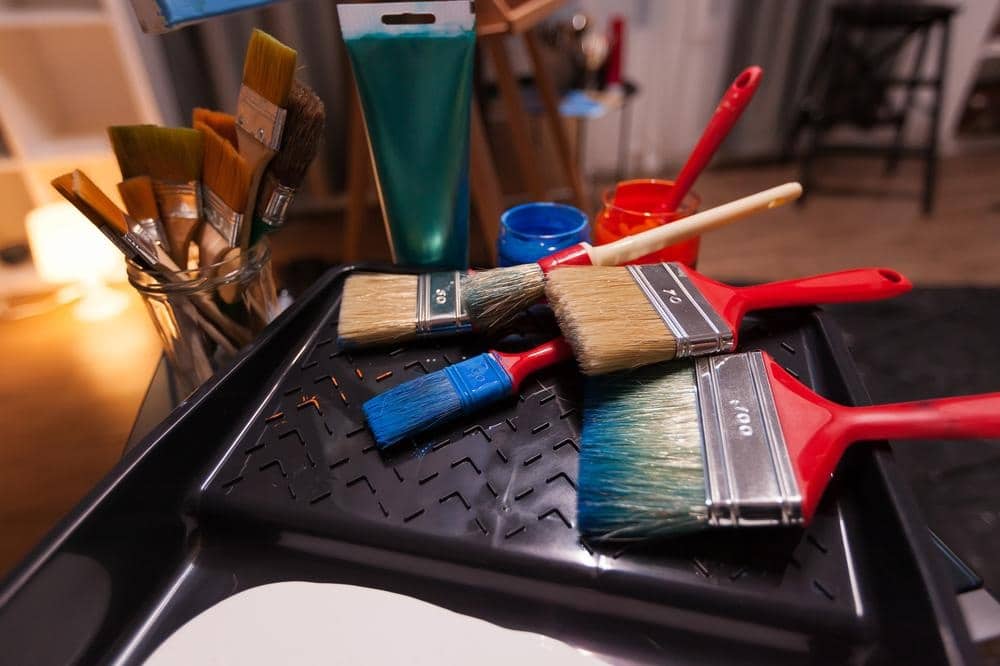
This is a great post for someone who has an appropriate closet. However, if you don’t have a closet near the kitchen or if all of your closets are full, you can have the next best thing.
You can make a freestanding cabinet-style pantry like this:
Follow the steps below to make something similar.
- You’ll need to measure and cut plywood for the back, sides, and doors, as well as the shelves.
- First, nail the top board to the sides and secure it with wood glue. After that has dried, you can add the bottom board. At this point, you’ll have a hollow square with no back and no front.
- Nails and glue are also used to secure your shelves. The back edges of the shelves should be flush with the sideboards but not extend all the way to the front.
- Nails and glue are used to fasten the backboard. You should nail in at all joints; nailing in the back to the shelves will also provide extra support.
- The doors are a little tricky, and you might need a helping hand to keep them straight (use your level!) while you attach them to hinges. When closed, you can use a magnetic closure to keep them neat and secure.
Conclusion
This guide has provided you with the information you need to convert your old coat closet into a pantry fit for a celebrity chef. Make use of that semolina flour you had forgotten you had!
How much does it cost to turn a closet into a pantry?
The average cost to build a walk-in pantry is $2,010. You’ll need about 1/4″ thick hardwood for the doors and flooring in order not to make any noise when walking across it or standing too close while shopping at night without lights turned on because your home has no windows facing outside so everyone can see what’s going down inside these days (shocking!). Reach In Pantries range from as low as 250 dollars all way up into thousands depending upon how many features are included, like custom moldings around door frames, etc.
Are walk-in pantries a waste of space?
If you’re looking to remodel your kitchen, it is important that the space allocated for a walk-in pantry does not exceed what would have been available in another area of the room. If this happens, then there could potentially be problems when trying to install other features such as an island or raised cooking surface due to limited head height restrictions from floor level
How do you make a homemade pantry?
Even if you don’t have a pantry, you can still organize your kitchen cupboards and drawers. Items you frequently use can be grouped. For instance, you can put salt, pepper, sugar, flour, butter, and milk in the same drawer. You will not lose track of where you are because you will be able to keep items together. You may also group items with similar characteristics. For instance, baking powder, baking soda, and yeast can be stored in one drawer. You can even keep your spices in one place and mark them with different coloring pens to see what they are.
How do you make a pantry when you don’t have one?
It is crucial to keep a well-stocked pantry in mind if you want to live a hassle-free life. You must know what items to purchase and how to store them properly. In addition to staples such as flour, sugar, pasta, beans, and cereal, pantry staples also include oil, vinegar, baking soda, salt, pepper, milk, butter, and eggs. You must check the expiration date on your items, so you do not run out of anything. Every six months, you should swap your inventory to ensure you never run out of anything.
Are walk-in pantries a waste of space?
There are some downsides to walk-in pantries, such as the fact that they require a lot of space and can take up valuable flooring in your kitchen. If you’re designing or remodeling an existing one, though, these drawbacks might not matter so much because it will just be used for storage rather than cooking from scratch
What to do when there’s no pantry in the kitchen?
To make an organization simple, it is best to label each can with the contents and date. Canned goods may be eaten right away, but organizing them can be a challenge if you don’t have a pantry. The following suggestions may help.
- Label each can with the contents and date. This way, you know what’s in it.
- Store your canned goods in a cool, dry place.
How do you organize cabinets if you don’t have a pantry?
A closet is where clothes are stored, and a pantry is where food items are stored. Both are used to store clothes and food, but if you want to turn a closet into a pantry, you must ensure certain things are taken care of. To begin with, the doors must be removed from the closet. Afterward, shelves may be installed on the walls of the closet in addition to the cabinets already on the shelves. This way, the clothes and other items in your cupboard can be sorted out easily.
How deep should a pantry closet be?
When designing and building a pantry closet, the depth of your closet should depend on the size and shape of the space, how much storage you need, what you’re storing in it, and how accessible you would like everything to be. Generally, a pantry closet should measure between 16 and 24 inches deep.
The width of a pantry closet typically ranges from 18″ wide for small spaces up to 36″ wide or more, depending on room size. A wider option will allow for greater storage capacity while making items easier to access. Additionally, you may opt for adjustable shelves that can accommodate taller items, such as standing bottles or cereal boxes.
Does a pantry need a door?
When it comes to deciding whether or not a pantry needs a door, there are several factors to consider. It is generally considered best practice for pantries to have a door for both safety and practicality reasons.
Firstly, having an enclosed space like a pantry with no door means that items can easily fall off the shelves and be lost in the back of the closet, making them difficult to access. If your pantry has walls but no doors, you may find yourself digging through clutter every time you try to find something. Additionally, if your kitchen also serves as an entertainment area or general living space having an open-air pantry could become aesthetically unpleasing. An enclosed door allows everything inside the closet to be neatly tucked away so it doesn’t interfere with the rest of your home decor.
Secondly, food safety is another important consideration when determining whether or not you need a door in your pantry closet. Without proper ventilation and insulation from external temperatures within the closed environment of an interior room (like most kitchens), perishables such as eggs, dairy products, and meats can spoil quickly due to changes in temperature throughout the day in addition to humidity levels fluctuating in between hot and cold cycles coming from outside elements which can push into spaces that don’t have protective barriers like closing doors installed.
A closed-in design prevents this issue by controlling airflow, which helps maintain consistent temperatures inside our kitchens, ensuring the freshness of all stored food items indefinitely until consumed within expiration dates previously established by authorized food industry experts around consumable commodities we put into our bodies amongst other things as well.
Do pantries add value to a home?
Yes, pantries can certainly add value to a home. Pantry closets are a great addition to any kitchen, providing more storage space as well as the convenience of having all your ingredients and food items in one place. A pantry is also an excellent way to keep organized and declutter your kitchen area.
The National Association of Realtors reported that potential buyers appreciate a well-stocked pantry closet because it signifies qualities such as organization and preparedness – qualities they may want in the owners of their new home. Moreover, an added bonus for buyers is that having ample pantry storage can reduce or eliminate the need for extra cabinets, freeing up space for other uses.
In addition to increasing appeal to potential real estate buyers, a well-organized pantry can help with budgeting by reducing food waste through better meal planning; the visibility of what you have on hand makes it easier for you or someone else in your household to plan meals efficiently with less spoilage involved since everything is easily accessible at once. It will also make grocery shopping much easier since it eliminates guesswork about what ingredients are missing from your supplies and ensures no redundant purchases are made weekly.
Can you turn a closet into a pantry?
Yes, you can transform a closet into a pantry by making a few modifications to the existing space. This conversion is an excellent option for those looking to create additional food storage in their home without undertaking a major renovation or construction project.
How much does it cost to convert a closet to a pantry?
The cost to convert a closet into a pantry can vary greatly depending on the size of the closet, the materials used, and the complexity of the project. On average, the cost can range from $300 to $2,000, which includes expenses for materials such as shelving, storage containers, and hardware, as well as labor costs if you choose to hire a professional for installation. However, by completing the project yourself and using budget-friendly materials, you can significantly reduce the overall cost.
How to build a pantry closet?
To build a pantry closet, follow these steps:
- Choose a suitable location: Select a closet or space in your home that is close to the kitchen and has enough room for your desired pantry size.
- Plan the layout: Determine the number and dimensions of shelves you will need based on the types of items you plan to store in your pantry.
- Gather materials: Purchase the necessary materials, such as shelving, brackets, and screws, based on your planned layout.
- Install shelves: Remove any existing closet rods or shelves, and then install the new shelves at the appropriate heights and depths.
- Add storage solutions: Use storage bins, baskets, or containers to keep your pantry organized and easily accessible.
- Label items: Clearly label your storage containers or shelves to make finding and retrieving items more efficient.
What is a secret pantry?
A secret pantry is a hidden storage area for food and other household items, designed to be concealed from view and known only to the homeowner or occupants. These pantries can be built behind a false wall, within a cabinet, or even behind a bookcase, providing an inconspicuous and secure storage solution. Secret pantries have gained popularity for their unique design and the added element of privacy they offer.
Can I Turn a Closet into a Pantry?
Yes, you can definitely turn a closet into a pantry. This is an excellent solution for kitchens that lack sufficient storage space. The conversion process involves removing any existing rods and shelves, then installing new shelving units or organizers that suit your pantry needs. You might also consider adding lighting for better visibility. Remember to plan your shelf heights based on the items you’ll be storing, with frequently used items within easy reach.
How Much Does It Cost to Convert a Closet to a Pantry?
The cost to convert a closet into a pantry can vary greatly depending on the size of the closet, the materials you choose for shelving, and whether you do it yourself or hire a professional. A basic DIY conversion can be done for under $100 using budget-friendly materials and simple shelving units. However, if you opt for custom-built shelves, high-end materials, or professional installation, the cost could go up to several hundred dollars.
How Do I Make My Closet Pantry Functional?
To make your closet pantry functional, start by planning your space according to the items you intend to store. Consider adjustable shelving for flexibility, allowing you to change the layout as your needs change. Use clear bins or baskets to group similar items together, making them easier to find. Install a light to improve visibility, especially if the closet is deep. If the pantry is tall, keep a step stool nearby for easy access to higher shelves. Lastly, maintain organization by regularly checking for expired items and reorganizing when necessary.

Experienced Executive Assistant with a demonstrated history of working within the furniture industry. Skilled in furniture styling, visual communication, project management, and proficiency with Adobe Creative Suite. Strong arts and design professional with a (BA) Creative Direction for furniture design focused on Industrial Design from School of the Art Institute of Chicago.
![How To Convert A Closet Into A Pantry [In 6 Steps]](https://bienalclosets.com/wp-content/uploads/2022/02/pexels-max-vakhtbovych-7746589.jpg)







